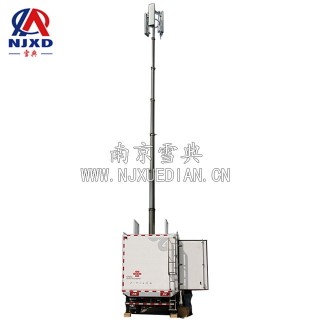NEWS
Main features of satellite communication for emergency command vehicle lifting
Time:2020-08-17 View:

Brief introduction of satellite communication
The lift communication command vehicle has satellite communication, ground wireless communication and other ways. Since the former Soviet Union launched the first artificial Earth satellite in 1957, artificial satellites have been widely used in communication, radio, television and other fields. On 1965, the first commercial international communication satellite was sent into synchronous orbit over the Atlantic Ocean, and commercial communication using stationary satellites began.
The satellite communication system consists of two parts: Satellite and earth station. Satellites act as relay stations in the air, that is, amplify the electromagnetic waves sent from the earth station and return them to another Earth station. The Earth station is the interface between the satellite system and the ground public network, and the ground users enter and exit the satellite system through the earth station to form a link. Since the stationary satellite is 3600Km above the equator, its cycle around the Earth is exactly the same as the rotation of the Earth (23 hours and 56 minutes 4 seconds), and it looks like motionless from the ground. Three satellites 120 degrees apart can cover the entire equatorial circle. Therefore, satellite communication is easy to realize cross-border and intercontinental communication. The most suitable frequency for satellite communication is 1-10GHz frequency band, namely microwave frequency band. In order to meet more and more needs, research and application of new frequency bands have been started, such as 12GHZ,14GHZ,20GHZ and 30GHZ.

The main features of satellite communications are as follows:
Advantages
(1) the communication range is large, as long as the beam coverage range emitted by the satellite can be used for communication.
(2) not easily affected by land disasters.
(3) the construction speed is fast.
(4) easy to realize broadcast and multiple access communication.
(5) the circuit and traffic can be adjusted flexibly.
(6) the same channel can be used in different directions and regions.
Disadvantages:
(1) as the distance between the two ball stations and the electromagnetic wave is 72000KM, the signal arrival is delayed.
(2) the frequency band above 10GHz is affected by rain and snow.
(3) the antenna is affected by solar noise.

In the microwave band, the working band of the whole communication satellite is about 500MHz wide. In order to facilitate amplification and transmission and reduce modulation interference, several transponders are usually set on the satellite. The operating band width of each repeater is 36MHZ or 72MHZ. At present, most satellite communications adopt frequency division and multiple access technology. Different earth stations occupy different frequencies, that is, different carriers are used. It is suitable for point-to-point large-capacity communication. In recent years, time division multiple access technology has been gradually adopted, that is, each Earth station occupies the same frequency band but occupies different time slots. It has a series of advantages over Frequency Division Multiple Access, such as no intermodulation interference, there is no need to use up-and-down frequency conversion to separate the signals of each earth station. It is suitable for digital communication and can be distributed according to the changes of business volume. New technologies such as digital voice insertion can be adopted to increase the capacity by 5 times. Another multiple access technology is code division multiple access (CDMA), that is, different earth stations occupy the same frequency and time, but there are different random codes to distinguish different addresses. It adopts extended spectrum communication technology, has the advantages of strong anti-interference ability, good confidential communication ability, flexible telephone scheduling, etc. The disadvantage is low spectrum utilization. It is more suitable for systems with small capacity, wide distribution and certain confidentiality requirements.
In recent years, the development of new satellite communication technologies has emerged one after another. For example, the very small aperture antenna Earth station (VSAT) system and the medium and low orbit mobile satellite communication system have received extensive attention and application. Satellite communication is also an important part of the future global information superhighway.

CATEGORY
NEWS
- Vehicle antenna lifting equipment system and technical parameters
- Main features of satellite communication for emergency command vehicle lifting
- Communication mode on emergency lifting communication command vehicle
- Portable pneumatic lifting LAMP application bracket load horizontal swing degree test
- 360 Rotating traffic accident lighting system vehicle-mounted hand surveillance camera